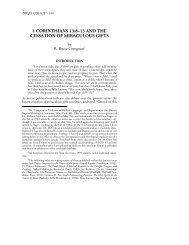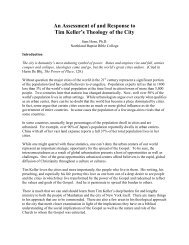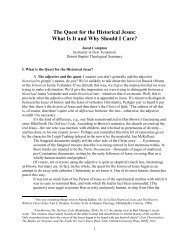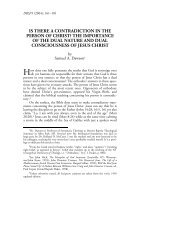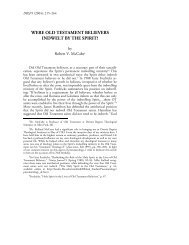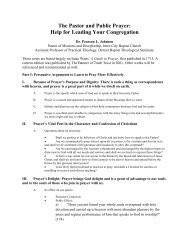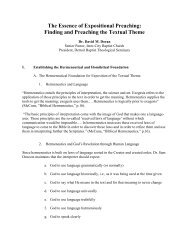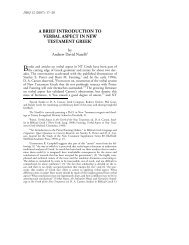Dispensational Sanctification: A Misnomer - Detroit Baptist ...
Dispensational Sanctification: A Misnomer - Detroit Baptist ...
Dispensational Sanctification: A Misnomer - Detroit Baptist ...
You also want an ePaper? Increase the reach of your titles
YUMPU automatically turns print PDFs into web optimized ePapers that Google loves.
102 <strong>Detroit</strong> <strong>Baptist</strong> Seminary Journal<br />
MODELS OF SANCTIFICATION<br />
We will consider five models of sanctification in this portion of<br />
the paper. 32 Rather than delineating the historical background and specific<br />
doctrinal details of each one, we will seek to broadly summarize<br />
the main emphases of each model and then provide some comparisons<br />
and contrasts between them. In particular our discussion of each<br />
model will center upon the significance of a post-conversion sanctification<br />
experience and the relationship between justification and sanctification.<br />
Wesleyan <strong>Sanctification</strong><br />
John Wesley’s main contribution to sanctification teaching is his<br />
separation of justification from sanctification, both of which are to be<br />
received in separate acts of faith. Wesley describes this sanctification as<br />
“entire sanctification” or “perfection.” 33 The experience of receiving<br />
this type of sanctification has five specific elements: 1) it is instantaneous;<br />
34 2) it is distinctly subsequent to justification; 35 3) it is only received<br />
by those who seek for it; 36 4) it defines sin as “conscious,<br />
deliberate acts”; 37 and 5) it may be lost. 38<br />
Thus, Wesleyan sanctification emphasizes the necessity of a postconversion<br />
experience of entire sanctification that is attained by an act<br />
of faith distinct from justification. In this model the relationship between<br />
justification and sanctification 39 is merely a possibility.<br />
32 These are the same five models presented in Five Views on <strong>Sanctification</strong> (Grand<br />
Rapids: Zondervan, 1987).<br />
33 John Wesley, “Scripture Way of Salvation,” in Sermons on Several Occasions, ed.<br />
T. Jackson, vol. 1 (New York: G. Lane and C. B. Tippett, 1845), pp. 386, 390.<br />
34 John Wesley, A Plain Account of Christian Perfection (Chicago: The Christian<br />
Witness Co., n.d.), pp. 25, 52, 104.<br />
35 Ibid., p. 46.<br />
36<br />
Ibid., p. 35.<br />
37 Ibid., pp. 26–28.<br />
38<br />
Ibid., p. 104.<br />
39 When using the term “sanctification” with justification in this discussion, we<br />
are specifically speaking of experiential or progressive sanctification. Most writers admit<br />
to some type of positional sanctification that occurs at the point of conversion, but<br />
our discussion here is centered upon the understanding of the relationship between<br />
justification and progressive sanctification.



